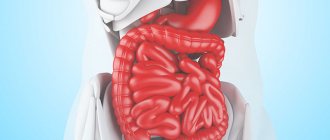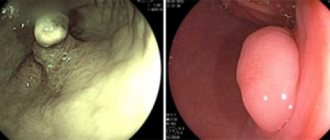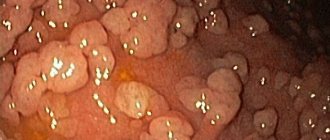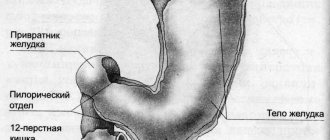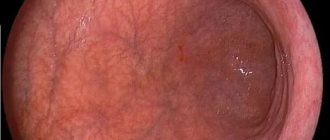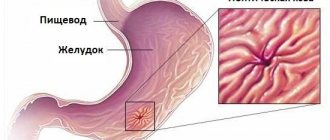Gastric adenocarcinoma is one of the most common types of cancer in this location. It accounts for up to 95% of all malignant neoplasms of the stomach. The disease is insidious in that in the initial stages it does not manifest itself in any way, then pain, nausea, loss of appetite occur, and against the background of these symptoms, weakness and weight loss increase. The only radical treatment for adenocarcinoma today is surgery. Radiation therapy and chemotherapy are prescribed as additional treatment or when surgery is not possible.
- Reasons for development
- Types of gastric adenocarcinoma
- Symptoms
- Diagnosis of gastric adenocarcinoma
- Stages of adenocarcinoma
- Diagnostics
- Metastasis of gastric adenocarcinoma
- Treatment of gastric adenocarcinoma
- Prognosis of gastric adenocarcinoma
- Prevention
Reasons for development
The cause of malignant transformation of mucosal cells has not been fully identified, but scientists have identified several factors that reliably increase this likelihood:
- Chronic atrophic gastritis. Against this background, up to 60% of all cases of stomach cancer develop. When the atrophic process is localized in the body of the stomach, the risk increases by 3-5 times, in its antral part - by 18 times, and if the entire stomach is affected - by 90 times.
- Malnutrition - consumption of large amounts of spicy and salty foods, marinades, smoked meats, dried meat, as well as fats, especially heat-treated ones. The nature of food intake matters. Overeating and insufficiently thorough chewing of food can lead to chronic trauma to the stomach wall and, against this background, to malignant degeneration of cells.
- Infection with the bacterium Helicobacter pylori increases the risk by 3-4 times.
- Smoking and alcohol abuse.
- A history of gastric surgery. The risk of developing cancer increases 4 times.
- Pernicious anemia is a pernicious anemia associated with the inability to absorb vitamin B12. Against this background, a decrease in immunity occurs, which in 10% of cases leads to the development of cancer.
- Immunodeficiency conditions, including AIDS.
- Hereditary predisposition, according to various authors, increases the risk by 5-20%. The scientific literature describes cases of inheritance of gastric adenocarcinoma.
- Working with harmful production factors (nickel, asbestos).
- Stomach ulcer. When it is located in the body of the stomach, the risks of malignancy increase by 2 times, but when the antrum is affected, this pattern is not observed.
Causes
The development of adenocarcinoma is based on damage to the cells of the glandular epithelium of the stomach by various factors:
- The role of the bacterium Helicobacter pylori in the pathogenesis of glandular cancer has been proven. This microorganism secretes substances that destroy the protective layer of mucus in the stomach, damaging the cells of the mucous membrane and causing chronic inflammation. The presence of gastritis, ulcers with proven Helicobacter infection is an indication for regular preventive examinations with FGDS (fibrogastroduodenoscopy).
- Foods rich in nitrites can also cause adenocarcinoma. These products include fried, smoked foods, fast food, and foods with a high content of preservatives.
- Lack of vitamins A, E, C in the body.
- Smoking, alcohol abuse.
- Hereditary factor. The presence of one of your relatives with this disease is a reason to closely monitor the health of your stomach.
- Duodeno-gastric reflux (reflux of food from the duodenum back into the stomach).
The following diseases predispose to the development of adenocarcinoma: gastritis, chronic gastric ulcer, polyposis, and the presence of dysplasia of the gastric epithelium.
Types of gastric adenocarcinoma
According to the modern classification, the following types of adenocarcinomas affecting the stomach are distinguished:
- Papillary - visually resembles a polyp.
- Tubular. Grows from cubic or columnar epithelial cells.
- Mucinous. Grows from mucus-producing cells.
According to the degree of differentiation, the following forms are distinguished:
- Well-differentiated adenocarcinoma of the stomach. Tumor cells have a high level of differentiation and “resemble” healthy tissue. It is characterized by slow growth and, with timely diagnosis, is highly treatable. The main problem is that at the very beginning this tumor is difficult to detect, even with endoscopic examination, and its detection at later stages does not allow achieving the desired result.
- Moderately differentiated gastric adenocarcinoma. The cells of this tumor are difficult to identify with the tissue from which it grows. It is characterized by moderate malignancy and growth rate.
- Poorly differentiated gastric adenocarcinoma. The cells of a given tumor cannot be identified with a specific tissue. This is the most malignant type of stomach cancer. Characterized by rapid growth and metastasis.
Classification of adenocarcinomas
When classifying cancer, the degree of differentiation is taken into account. The higher it is, the more the tumor cells resemble normal, healthy epithelial cells. The lower the tumor is differentiated, the more dangerous and malignant it is. According to this classification, adenocarcinomas are divided as follows:
- highly differentiated;
- moderately differentiated;
- low-differentiated (poorly differentiated).
Based on their appearance and growth pattern, there are the following types of adenocarcinomas:
- ulcer-cancer - the tumor has a flat shape with ulceration in the center;
- polypoid cancer - looks very similar to a stomach polyp, has clear boundaries;
- scirrhus - grows into the stomach wall over a long distance, giving early metastases;
- ulcerated cancer - looks very similar to an ulcer, an accurate diagnosis can only be established after a biopsy;
There is also a gradation based on the histological picture of the tumor - tubular, papillary, mucous adenocarcinomas.
Symptoms
- Loss of appetite.
- The symptoms of dyspepsia are bloating, nausea, belching, a feeling of heaviness. If the tumor is large, it can block the lumen of the stomach, which causes vomiting when eating, but this happens in the last stages.
- Weakness and apathy.
- Pain. As a rule, it does not occur immediately, but mainly at advanced stages. At this time, it is permanent and does not depend on food intake. It occurs for no apparent reason and often worsens after eating. In the final stages, it is so strong that it cannot be stopped with the usual analgesics.
As we can see, these symptoms are nonspecific, and a person can try to stop them on their own for a long time.
Stages of stomach removal
The course of the operation to remove all or only part of an organ (resection) proceeds according to the same plan, but with a different volume of tissue removed.
- First, mobilization is carried out - cutting off the organ from the internal ligaments that fix it, ligating the supplying arteries and veins. At the same time, a thorough examination of the abdominal organs is carried out and, based on what is seen, adjustments are made to the operation plan.
- The second stage is the actual removal, with cutting off the stomach from the esophagus and duodenum. When nearby organs of the abdominal cavity are involved in the tumor conglomerate, including the diaphragm or liver, pancreas or large intestine, if technically possible, complex and extensive combined operations are performed, that is, gastrectomy and, for example, resection of the pancreas or liver.
- The third stage is the restoration of the digestive tract, that is, the connection of the esophagus with the intestines, which will ensure the further movement of food.
Diagnosis of gastric adenocarcinoma
Timely diagnosis of stomach cancer is of utmost importance, since the prognosis in the early stages of the disease is much more favorable than with a widespread tumor process. But adenocarcinoma in the initial stages is characterized by either an asymptomatic course, or its symptoms are perceived as signs of another disease, for example, gastritis, ulcers, cholelithiasis, pancreatitis. As a result, patients do not go to the doctor and relieve symptoms on their own using medications purchased at the pharmacy.
Etiology
Medicine still does not know the exact etiological factors that provoke the appearance of adenocarcinoma. Doctors believe that a tumor can form due to prolonged exposure to carcinogenic components due to deterioration of excretory function and impaired circulation.
The degeneration of benign cells into malignant ones, as a rule, is formed due to heredity, poor nutrition and a number of household factors.
The following factors can also cause the disease:
- excess weight;
- radiation exposure;
- living in an environmentally hazardous area;
- reduced level of hydrochloric acid in the stomach;
- excessive salt consumption;
- lack of ascorbic acid.
Often the disease affects the body of men in old age. The disease progresses especially quickly in those people who actively drink alcohol and smoke. First, proliferative processes begin in the body, and then cancer itself forms.
The following factors also influence the development of adenocarcinoma:
- a diet low in dietary fiber, vitamins and antioxidants;
- pernicious anemia;
- atrophic gastritis of chronic type;
- adenomatous polyp of the stomach;
- hyperplastic gastritis.
Medicine has determined that cancer will never form in the body of a healthy person. Precancerous pathologies that can develop into cancer include the following ailments:
- gastritis;
- polyps;
- ulcers;
- changes in the structure of the stomach.
Stages of adenocarcinoma
- Stage 0 or cancer in situ. Malignant cells do not spread beyond the epithelial layer.
- Stage 1. The tumor grows into the epithelium and spreads to other layers of the stomach wall, but does not go beyond it.
- Stage 2. The tumor increases in size and metastasizes to regional lymph nodes.
- Stage 3. Adenocarcinoma grows into neighboring organs (pancreas, liver) and/or metastasizes to several groups of lymph nodes.
- At the fourth stage, adenocarcinoma metastasizes to distant organs and lymph nodes.
Complications
The main complications of adenocarcinoma are associated either with an advanced pathological process or with treatment.
- If a tumor grows into the wall of the stomach and damages large blood vessels, a person will experience periodic or constant bleeding of varying intensity, from dripping to profuse (heavy).
- The presence of metastases in the liver, lungs and other organs disrupts their functioning and can lead to the development of failure (liver, pulmonary).
- The location of the tumor in the area of the pylorus leads to its stenosis.
- When the tumor compresses the blood vessels, venous circulation in the abdominal cavity is disrupted, which leads to ascites (fluid accumulation in the abdominal cavity).
The main complication of surgical treatment of cancer is bleeding from the gastric stump, the formation of pronounced scars in the area of the postoperative wound and disruption of the passage of food through the stomach. In some cases, it may be necessary to apply a gastrostomy, i.e., create a “bypass” for food.
Diagnostics
Diagnosis of gastric adenocarcinoma is complex and includes a number of examinations that not only help determine the type of tumor, but also the stage of the disease:
- FGDS is an examination that is carried out using a special device - a flexible endoscope. With its help, a visual examination of the gastric mucosa is carried out, and the device transmits an enlarged image of the area under study to the monitor, which makes it possible to detect minor changes in the mucosa. Secondly, the endoscope is equipped with a special manipulation system, with which you can take a piece of tissue for histological analysis and accurately determine the type of tumor and the degree of differentiation of its cells.
- Ultrasound. This research method makes it possible to clarify the size of the tumor, its relationship with neighboring organs, and the presence of metastases in regional lymph nodes.
- CT and MRI also help verify the size of the malignant tumor and its ingrowth into surrounding tissues, but the main goal is to look for metastases in the lymph nodes and distant organs (for example, the lungs).
- PET-CT (positron emission computed tomography) can detect distant metastases up to 1 mm in size.
- Determination of tumor markers CEA, CA72-4, CA19-9. In gastric cancer, these markers do not have diagnostic value as such, but if the norm is initially elevated, they can be used to monitor treatment and relapse. After surgery, the level of tumor markers should decrease, it may reach normal. If a relapse or progression of the disease occurs, it will increase again.
Dr. M.S. Burdyukov conducts a diagnostic examination of the stomach - FGDS
Diagnosis of pathology
The first question that all patients with a similar disease ask is how long they have left to live and whether it is possible to somehow alleviate the condition. The answers to these questions directly depend on how quickly the diagnosis is made. Therefore, the diagnosis of pathology is especially important. All possible methods are used. The following are especially important:
- FGDS - thanks to this method, it is possible to visually examine the stomach tissue, assess the condition and size of the formation. If necessary, tissue is taken for biopsy.
Diagnosis of stomach cancer is carried out using phagogastroduodenoscopy
- Histological examination is precisely thanks to which it is possible to accurately determine the diagnosis. In the laboratory, the obtained tissues are examined. In the presence of a poorly differentiated tumor, the cells have a characteristic shape and structure.
- Blood test - in addition to traditional studies, it is mandatory to determine markers characteristic of this particular formation.
- X-ray – a contrast agent is used during the procedure. It can be used either orally or administered intravenously, the latter option being more informative.
- Tomography is an expensive procedure, but it is precisely because of it that it is possible to assess the condition of neighboring organs and identify the presence of metastases. In addition, such a study is used in cases where surgery has already been performed and chemotherapy is being performed. Thanks to MRI, it is possible to assess the condition of the remaining nodes and their response to treatment.
MRI is performed to detect metastases
- Ultrasound is the first test ordered when cancer is suspected. The procedure is simple and accessible to everyone. In addition, the results are obtained immediately, which is especially beneficial in terms of treatment.
- Laparoscopy is performed for diagnostic purposes. Especially often during manipulation it is possible to identify nodes in the liver, peritoneum, and so on.
The final diagnosis is made only after a complete examination, and the most reliable information is provided by histological tissue analysis. Only after this can treatment begin.
If gastric cancer is suspected, an ultrasound scan is prescribed.
Metastasis of gastric adenocarcinoma
Adenocarcinoma is characterized by lymphogenous, hematogenous and implantation metastasis.
Implantation metastasis involves the spread of cells through contact of a tumor with a host surface. In the case of stomach cancer, such a surface may be the peritoneum, pleura, pericardium, or diaphragm. At the fourth stage, carcinomatosis (massive metastasis to various tissues) is often detected.
Lymphogenous metastasis involves the spread of the tumor through the lymphatic vessels. First, nearby lymph nodes are affected, and then more distant ones. For stomach cancer, there are specific forms of lymphogenous metastases:
- Damage to the nodes of the left supraclavicular region is Virchow's metastases.
- Damage to pararectal lymph nodes—Schnitzler metastases.
- Damage to axillary lymph nodes—Irish metastases.
Hematogenous metastasis involves the transfer of cancer cells through blood vessels. The liver is most often affected as a result of cell migration through the portal vein. Damage to the lungs, kidneys, brain, and bone marrow is also possible.
To which organs does stomach cancer most often metastasize?
Tumor cells can spread from the stomach to other organs in different ways:
- Cancer can directly grow into neighboring organs. Most often - into the pancreas, less often - into the transverse colon, the left lobe of the liver.
- Sometimes cancer cells spread along the surface of the peritoneum , a thin film of connective tissue that lines the inside of the abdominal wall and covers the internal organs. In this case, women often have metastases in the ovaries ( Krukenberg tumor ).
- By hematogenous route (through the bloodstream), stage 4 stomach cancer most often spreads to the liver, less often to the lungs and bones.
- Lymphogenic spread of cancer cells occurs along the hepatoduodenal ligament , celiac trunk , and splenic vessels.
With stomach cancer, specific metastases can occur. There are special names for them:
- Virchow's metastasis - in the lymph node located above the collarbone.
- Metastasis of Sister Mary Joseph - to the navel.
- Schnitzler metastases - to the lymph nodes located around the rectum.
- Irish metastases - to the lymph nodes located in the axillary region.
According to statistics, stage 4 gastric cancer most often metastasizes to the liver (48% of patients), peritoneum (32%), lungs (15%), and bones (12%).
Treatment of gastric adenocarcinoma
Treatment of adenocarcinoma depends on the stage of the disease and the histological type of the tumor. As a rule, it is complex and involves a combination of surgery with chemotherapy or radiation therapy. The surgical component here is the key factor.
Treatment may involve removing the entire stomach (gastrectomy) or part of it (gastrectomy). At the same time, tissues affected by malignant cells are removed - regional lymph nodes, parts of organs where the tumor has grown (liver, small intestine, peritoneum, etc.).
Chemotherapy and radiation therapy can be used preoperatively (neoadjuvant regimen) and postoperatively (adjuvant regimen). In the first case, their goal is to reduce the size of the tumor so that it can be removed with the least amount of tissue, and in the second, they aim to destroy the remaining cancer cells. In addition, the use of chemotherapy and radiation therapy can reduce the severity of pain.
If radical removal of the formation is not possible, palliative treatment is carried out. In this case, it is aimed at eliminating complications caused by adenocarcinoma and improving the patient’s quality of life. For example, if a tumor has blocked the lumen of the stomach, bypass anastomoses are performed or a gastrostomy tube is removed, so that the patient can eat.
Treatment
Several methods are used in the treatment of adenocarcinoma - surgery, chemotherapy, and radiation therapy. There are also traditional medicine recipes, and active research is underway into the possibility of using stem cells to treat cancer.
The type of treatment, its volume and duration are entirely determined by the type of tumor, the degree of its progression, the development of metastases, as well as the general condition of the patient and the presence of concomitant diseases. The range of methods used varies from surgery alone to a combination of all types of treatment.
- Surgery. It is the only type of therapy that allows (in the absence of metastases) to completely remove cancer cells from the body. It is used for almost all stages of cancer, except for cases where the tumor has reached such a size or has grown into so many structures of the abdominal cavity that it is not possible to remove it. Usually in this case, the changes in the body are so great that the patient is prescribed palliative therapy, i.e. treatment aimed at relieving pain and improving the quality of life.
- Chemotherapy. Used to slow tumor progression, spread of metastases, and relieve symptoms. Prescribed after surgical treatment alone or together with radiation therapy. Even modern chemotherapy drugs are quite toxic, they have side effects such as nausea, vomiting, baldness, weight loss, but it should be remembered that this is a necessary stage of treatment, and the unpleasant consequences of their use are temporary.
- Radiation therapy. This is a non-invasive (no physical intervention in the body), painless procedure. Certain areas of the body (stomach stump after surgery, lymph nodes, organs with metastases) receive a certain type of radiation. This allows you to destroy cancer cells that could remain in the stomach after surgery, relieves pain, reduces the risk of spread and growth of metastases, and reduces the likelihood of bleeding in the postoperative period.
- Immunotherapy. The use of drugs that affect the human immune system in order to reduce the intensity of metastasis, activate the body’s natural antitumor defense factors, and reduce the likelihood of tumor recurrence.
- Stem cell treatment. A new, experimental, but promising treatment method. Currently available only in the largest clinics in the country.
- Treatment with folk remedies. There are several traditional medicine recipes used for stomach cancer:
- Aconite tincture. You need to take 100 grams. aconite root, wash and pour boiling water for an hour. Then grind and pour 60 degree alcohol for 21 days. Take dissolved in 200 ml of warm water 30 minutes before meals for 10 days, starting with 1 drop, adding 1 drop daily.
- Potato-colored decoction. Collect potato flowers and dry in a dark place, then chop. Pour one tablespoon of raw material into 500 ml of boiling water and leave for 3 hours. Take 150 ml 3 times a day 30 minutes before meals for 2 weeks. After a week's break, repeat the course. Treatment lasts 6 months.
- Nut tincture. Chop 33 walnuts and pour vodka for 40 days. Strain the resulting tincture, take 1 teaspoon before meals 3 times a day. Store in a dark glass container in the refrigerator.
Folk remedies in the photo
The prepared nut tincture should be stored in the refrigerator.
Potato flowers should be collected during the period of full flowering.
Ready-made tincture of aconite can be bought at a pharmacy
Remember that traditional medicine can relieve symptoms and improve the general condition of the body, but do not replace traditional cancer treatment!
Prognosis of gastric adenocarcinoma
The prognosis for adenocarcinoma depends on the stage of the disease. The sooner treatment begins, the more effective it will be:
- In the first stage, the five-year survival rate reaches 80%. Moreover, the chances of a full recovery are high. Unfortunately, at this stage, stomach cancer is detected very rarely, usually by chance.
- In the second stage, the five-year survival rate approaches 55%. Half of these people have a chance of complete recovery. According to the literature, less than 10% of malignant gastric tumors are detected at the second stage.
- In the third stage, the five-year survival rate is less than 40%, and in the fourth stage it does not exceed 5%. Unfortunately, up to 75% of adenocarcinomas are detected at the fourth stage.
Stages of disease development
| Stage | Degree of stomach damage | Recovery prognosis |
| Initial | The mucous membrane is affected, the lymph nodes are not affected | High |
| First | The tumor grows into the mucous membrane and affects local lymph nodes | 60-80% |
| Second | The tumor grows to the muscle membrane and affects regional lymph nodes | 30-40% |
| Third | Damage to all linings of the stomach, regional and distant lymph nodes | 12-20% |
| Fourth | Metastases to other organs | less than 5% |
Unfortunately, the initial stage is rarely diagnosed; most often it is a finding during routine diagnostic studies. Survival in later stages is 5 years, but beyond this threshold the prognosis rises to 10 years. Young (under 50 years of age) patients have a higher chance of recovery than older patients - 20–22% and 10–12%, respectively.
Prevention
Prevention of stomach cancer is aimed at preventing or reducing exposure to risk factors leading to the development of this disease:
- Normalization of nutrition. Eating enough dietary fiber (vegetables, fruits, cereals), limiting the consumption of salt, spices, marinades and smoked meats.
- Quitting smoking and alcohol abuse.
- Treatment of infections and precancerous diseases - chronic gastritis, stomach polyps.
- Maintaining adequate levels of physical activity
| More information about the treatment of stomach cancer at the European Clinic: | |
| Treatment of stomach cancer | |
| Oncologist-gastroenterologist | 5100 rub. |
| Chemotherapy appointment | 6900 rub. |
| Emergency oncology care | from 11000 rub. |
| Radiologist consultation | 10500 rub. |
Book a consultation 24 hours a day
+7+7+78
Pathology prognosis
As already mentioned, the prognosis for this form of cancer is unfavorable. This is especially true in cases where pathology is detected at stages 3-4. As a rule, the treatment only allows to stop the growth of the formation, but does not get rid of it. If it is possible to identify the disease at the first stage, then nine out of ten patients are completely cured. At the same time, they are required to constantly follow a diet and undergo regular examinations.
At the second stage of the pathology, cure is possible in 50% of cases, but again, subject to well-chosen treatment. But at the third and final stage, cell cancer is no longer curable. All measures are aimed only at alleviating the patient’s condition.
The video contains detailed information about methods of treating stomach cancer:
Esophageal adenocarcinoma: symptoms, diagnosis, treatment, risks, survival
Adenocarcinoma is a cancerous tumor that develops from mucus-producing glandular cells located in the inner layer of the wall of the esophagus. Its growth begins from the lower part of the organ, which is located next to the stomach.
Every cancer patient wonders why this happened to him.
The answer is both simple and complex at the same time.
The mechanism of cancer occurrence is known. It all starts with the fact that ordinary healthy cells in our body begin to change - mutate. This is normal and happens to everyone, but usually the body copes with these cells and the tumor does not develop. You can read more about the occurrence of oncology in our short article, written in very simple language, “What is cancer and why does it occur.”
Each type of oncology has its own so-called risk factors - reasons that can trigger its occurrence. There are several such reasons for adenocarcinoma, you can read about them below, in a special section, and in our general article on esophageal cancer. However, it also happens that a person leads a fairly healthy lifestyle - plays sports, eats right, does not drink or smoke, but still gets sick. Maybe it’s heredity, or the body simply couldn’t cope – it couldn’t recognize dangerous cells. Unfortunately, not all cases of oncology can be explained using existing knowledge.
Adenocarcinoma is not the only type of esophageal cancer.
Squamous cell carcinoma is most common in Russia and post-Soviet countries, and its prognosis is usually worse than that of adenocarcinoma.
Valentin Semushin,
oncologist, surgeon, “Medicine 24/7” clinic
“Esophageal cancer is one of the most aggressive malignant diseases; it ranks 8th in mortality among all types of oncology. The disease is more common among men than women, which is often associated with lifestyle.”
What is cancer and why does it occur? October 30, 2020704 47
Symptoms of an esophageal tumor
The first warning sign of RP is dysphagia (occlusion of a third or half of the esophagus). At first it manifests itself in difficulty swallowing solid food, then it becomes difficult to swallow even porridge and liquid. When the tumor reaches a large size and compresses the esophagus, the final degree of dysphagia develops - complete closure of the esophagus.
Symptoms of esophageal adenocarcinoma are:
- pain, heaviness and discomfort behind the sternum;
- belching, regurgitation of food;
- pain while swallowing;
- nausea and vomiting.
- heartburn;
- increased salivation;
- bad breath.
The appearance of these symptoms already indicates that the process is neglected.
Signs of tumor spread beyond the esophagus:
- hoarseness or change in voice;
- bradycardia;
- enlarged lymph nodes;
- coughing;
- shortness of breath;
- internal bleeding (manifested as vomiting blood or dark stools).
Common symptoms of cancer include: weakness, severe weight loss, anemia, and fever.
Prevention of esophageal adenocarcinoma
For those who have already been treated for adenocarcinoma of the esophagus or understand that their chance of getting sick is high, doctors recommend taking measures that will reduce the risks:
- eliminate thermal and mechanical damage to the esophageal mucosa, that is, avoid very cold, hot and spicy foods and drinks, as they can lead to injury to the wall of the organ;
- give up alcohol and tobacco in any form, including snorting and chewing - their use causes cells to mutate, that is, change and turn into cancerous ones;
- examine the gastrointestinal tract and treat all its diseases, especially precancerous ones (Barrett’s esophagus, achalasia cardia, gastroesophageal reflux disease);
- eat right and maintain optimal weight;
- Be sure to lead an active lifestyle and get as much physical activity as possible.
Valentin Semushin,
oncologist, surgeon, “Medicine 24/7” clinic
“To prevent the development of adenocarcinoma of the esophagus, it is necessary to eliminate alcohol and smoking, and control body weight. In case of Barrett's esophagus, achalasia cardia, cicatricial stricture of the esophagus or chronic esophagitis, it is very important to undergo regular endoscopic examination with biopsy."
You can read more about the prevention of adenocarcinoma in our general article about esophageal cancer.
Reasons for the appearance of education
Most often, the disease occurs as a result of a severe disruption of the blood supply and nutrition of the walls, as well as suppression of secretion in the organ. These changes are mainly caused by the carcinogenic effects of certain substances.
The main causes of adenocarcinoma:
- Negative effects of tobacco tar and ethyl alcohol. Cancer is often diagnosed in people who smoke and drink alcohol for a long time;
- An unhealthy diet increases the risk of developing the disease. Abuse of fatty, smoked and salty foods negatively affects the condition of the mucous membrane, which provokes a change in normal glandular cells into atypical ones;
- Many girls follow strict diets for a long time, which leads to the body not receiving enough fiber, vitamins, minerals and other beneficial substances.
Scientists believe that moderately differentiated and other forms of adenocarcinoma also occur in people with a genetic predisposition. The presence of gastritis, ulcers and polyps increases the likelihood of developing cancer. According to statistics, most patients with this problem live in places with poor ecology and are over 50 years old.


